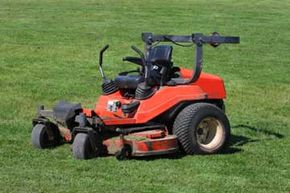Max Swisher really loathed mowing the lawn, so he set his sights on coming up with ways to make it as painless as possible. He would anchor his lawn mower to a tree, for example, and let it propel itself automatically in gradually shrinking circles until all the grass was cut. But perhaps his most ingenious contribution to the realm of lawn upkeep was his 1956 alleged invention of the zero-turn mower. Unlike other types of riding lawn mowers built based on front-wheel-steering designs, zero-turn mowers pivot around the rear wheels and turn on a dime. Unfortunately for Swisher, however, it's not the only company claiming dibs on the creation of the zero-turn lawn mower [sources: Swisher, Maxwell].
There's also the story of John Regier told by the folks at Hustler Turf. According to this claim, the invention of the zero-turn lawn mower didn't take place until 1963, when Regier adapted the steering system and transmission designs used in some agricultural equipment he helped develop while working at the Hesston Corporation, to create the first zero-turn mower. Apparently it was his wife's dislike of lawn care that spurred Regier on [source: Hustler Turf].
Advertisement
Most zero-turn riding lawn mowers don't come with a steering wheel; instead, they frequently have two levers that control two motors connected respectively to each rear wheel. They typically steer something like this: Pushing both levers forward causes the mower to move forward, while pulling them back causes it to reverse. The farther you push in either direction, the faster you go. To curve right, you push the left handle farther forward than the right handle, and vice versa if you want to curve left. If you want to make a swinging turn -- which leaves no grass uncut and sets you up that much faster for your next pass down the yard -- simply push the appropriate handle forward while keeping the other one in neutral, causing the mower to pivot around the stationary wheel. You can also spin around completely in place by moving one lever forward and pulling one lever back with equal force, in which case you'll be pivoting the mower around the central point between the two drive wheels.
Many zero-turn mowers are more appropriate for larger commercial or industrial applications, but some are small enough to be useful (and reasonably priced) for practical residential use. On the next page, we'll learn about this inspired system, as well as the benefits it brings to sweaty people mowing on steamy summer days.
Advertisement


